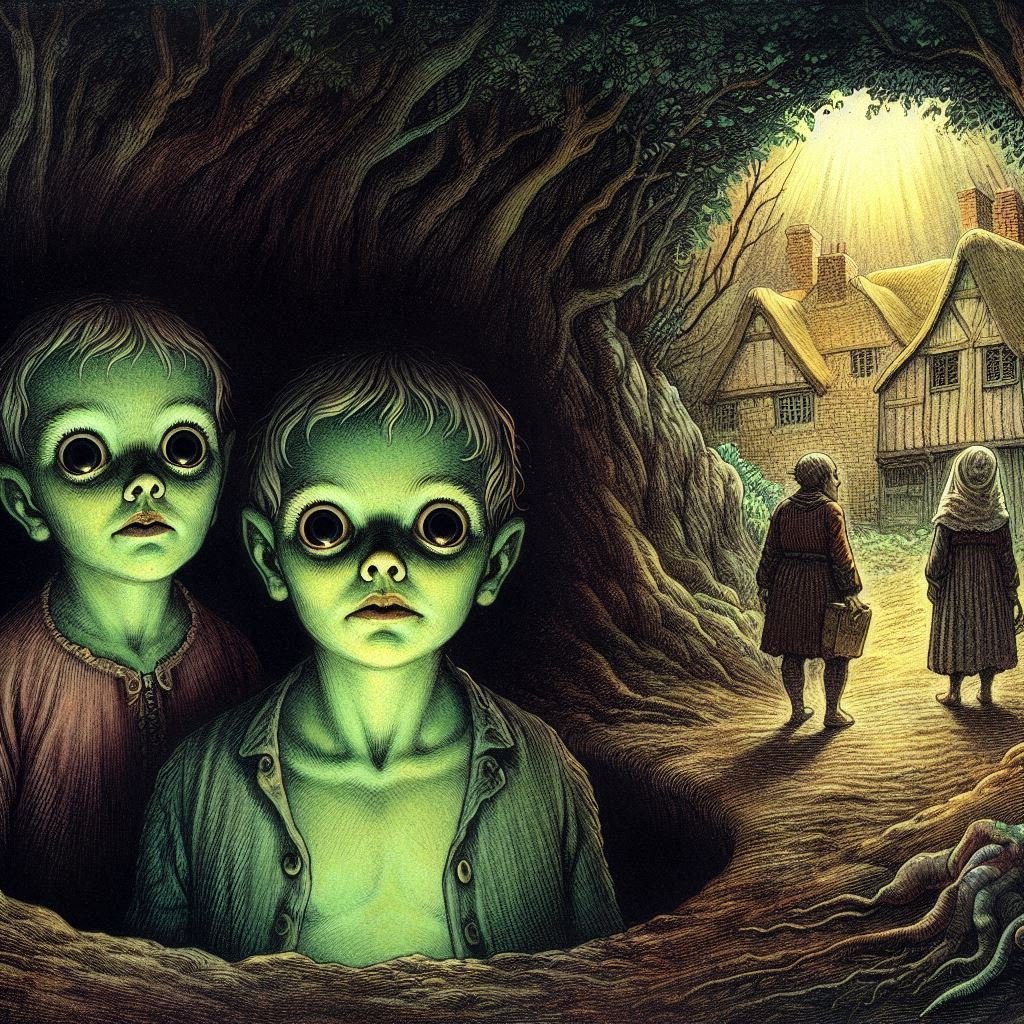Listen to “The Green Children” on Spreaker.
The Green Children of Woolpit
A Strange, Dark, and Mysterious Tale from Medieval England
Alright, picture this.
It’s a warm summer day in the middle of the 12th century—somewhere between the years 1150 and 1173—in the small village of Woolpit, England. Back then, life was rough. Most people were poor farmers. They lived off the land. There were no phones, no cars, no electricity. Just simple people, trying to survive each day.
Woolpit itself was named after “wolf pits”—deep holes dug to trap wolves that roamed the countryside. It was a quiet place. Safe. Predictable.
That is, until one day… something happened.
Something no one could explain.
And what came out of one of those wolf pits?
Changed the village forever.
Two Children Appear… But They Aren’t Normal
It was harvest season. Farmers were out in the fields working when they noticed movement near one of the old wolf pits on the edge of the village.
A group of villagers rushed over to see what it was.
What they found?
Would leave them speechless.
Two children—a young boy and a young girl, maybe 8 to 10 years old—were crawling out of the pit.
They were dirty. They looked lost. Their clothes were weird—made from fabric and stitched in ways nobody had ever seen before.
But the thing that made everyone stop and stare?
Their skin.
It was green.
Not just pale or sickly.
Green.
Bright, leaf-colored, forest green.
The villagers froze. Were these demons? Fairy creatures? Ghosts? They didn’t know what they were looking at—but it wasn’t normal.
And when the kids tried to speak?
It got even weirder.
They didn’t speak English—or any language the villagers understood.
The children were frightened, confused, and spoke in fast, strange-sounding words no one could make sense of.
Still… the villagers couldn’t just leave them.
So they brought the kids to a nearby manor house, owned by a man named Sir Richard de Calne. He took them in and told his staff to help them.
That was just Day One of what would become one of the strangest mysteries in British history.
They Wouldn’t Eat Anything
Once inside, the villagers tried to help.
They gave the children food—fresh bread, cheese, roasted meat. But the kids refused to eat. Every dish was pushed away. They were starving, but they wouldn’t eat anything.
Days passed. They grew weaker. Their green skin looked even more pale and sickly now. Everyone thought they were going to die.
And then… something strange happened.
Someone brought them a bowl of raw broad beans—still in their pods.
Suddenly, both kids lit up.
They grabbed the pods like it was the only food they’d ever seen. But instead of biting them whole, they seemed confused. They didn’t know how to open the pods.
A servant showed them how to crack them open.
Once they figured it out?
They ate like animals—gorging themselves on the beans. It was the first food they accepted.
For weeks, broad beans were the only thing they would eat.
But it kept them alive.
And slowly, they began to get stronger.
A Mysterious Recovery… and a Tragic Loss
As the months passed, the children began trying other foods—bread, fruit, bits of cooked vegetables. They grew healthier.
And most oddly of all?
Their green skin started to fade.
It was slow, but clear. The vibrant green hue softened, faded, and turned pinkish. After a few months, they looked more or less like normal children.
But just as things were getting better, tragedy struck.
The boy, who had always seemed more fragile, became sick again.
And this time, he didn’t recover.
Despite everything the villagers did… he died.
He was buried in Woolpit. His name was never known.
But the girl survived.
And it was she who finally began to speak—first with gestures, then words. Slowly, with help from her caretakers, she learned English.
And when she was finally able to explain where she came from?
Her answer made no sense at all.
St. Martin’s Land
According to the girl, she and her brother came from a place called “St. Martin’s Land.”
She said everyone there was green—just like they had been.
She said the sun never fully rose in that place. It was always twilight—never day, never night. Just dim, greenish light, like early dawn or late dusk.
She said they lived underground, or in a world beneath this one.
She claimed that one day, she and her brother were herding animals near their home when they heard the sound of bells ringing. They followed the sound into a long, dark tunnel. They walked for a long time in complete darkness.
And when they came out the other side?
They were blinded by the sunlight.
They didn’t know where they were.
They wandered for a while—and somehow ended up in the wolf pit.
And that’s where the villagers found them.
A Life After Mystery
Eventually, the girl was baptized and given a new name: Agnes.
She stayed in Woolpit for years, working in Sir Richard’s household as a servant. She grew into adulthood, lost her strange accent, and learned to live like everyone else.
Some stories say she later got married and moved to a nearby town.
But even as she built a normal life, the mystery of where she came from never went away.
Was This Even Real?
Here’s the part that’s really weird:
This wasn’t just a village rumor. Two famous historians from the 12th century—William of Newburgh and Ralph of Coggeshall—both recorded this story in their official histories of England.
They said it really happened.
They described the kids’ green skin, their refusal to eat, the strange language, the story about St. Martin’s Land. All of it.
So how do we explain this?
Let’s break down the main theories.
Theory 1: Chlorosis (Green Sickness)
One medical theory is that the kids had a condition called chlorosis—an extreme form of iron deficiency anemia.
When someone has this condition, their skin can take on a pale green tint. It was common in the Middle Ages due to poor diet.
This would explain:
-
The green skin
-
Their weakness
-
Why the color faded once they ate better food
But… chlorosis doesn’t explain:
-
The strange language
-
The tunnel story
-
Their weird clothes
Theory 2: They Were Flemish Refugees
This is a newer theory, but it’s interesting.
Back in the 1100s, many Flemish people (from modern-day Belgium) were living in England. But they spoke a different language and wore different clothes.
When a new king came to power, many of these families were killed or forced to flee. Some historians think the green children were Flemish orphans hiding in the woods.
Maybe they got lost, fell into the wolf pit, and were rescued by villagers who had never seen anyone like them.
That would explain:
-
The foreign language
-
The strange clothes
-
Their confusion and fear
-
The “St. Martin’s Land” could have been a reference to Fornham St. Martin, a nearby village
And their green skin? That could still be from malnutrition.
It’s a compelling theory—but there’s still no proof.
Theory 3: A Fairy Tale That Got Out of Hand
Some believe the story was never real at all—just medieval folklore written down by historians who thought it was true.
Maybe it started as a local legend that morphed into “fact” over time.
But here’s the thing…
Both William and Ralph—the historians—were known for being serious and factual. They weren’t the type to record myths as reality.
So if they wrote it down?
They believed it happened.
So What Really Happened?
Was this a medical mystery?
A story about two lost orphans?
Or were these children really from a place no one else has ever seen—a world beneath our own?
We’ll probably never know for sure.
But what we do know is this:
Two children showed up in Woolpit. They were green. They spoke no known language. They told a story no one could explain. And then… they were gone.
If you made it this far, thank you. You’ve just heard one of the oldest unsolved mysteries in English history.
What if it’s true?
If you like true stories like this—strange, dark, and mysterious—stick around.
Because the truth?
It’s always weirder than fiction.




